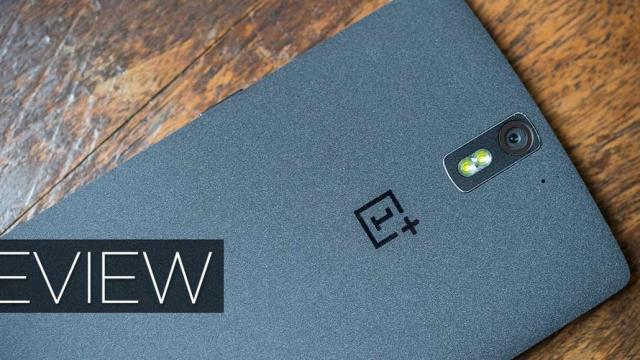Maybe you’ve heard of the OnePlus One. It’s the self-styled “flagship killer” aiming to swoop in from China and beat the Nexus 5 at its own affordability game. That’s a tall order, but the OnePlus One fills it. It’s so dirt cheap, and so incredible, that it’s damn near unbelievable.
What Is It?
A high-quality, $529 phone ($US300 for our Amerifriends) that runs Cyanogenmod — a modded version of Android that’s popular with tinkerers — out of the box.
A Nexus in everything but name. A 2.5 GHz Snapdragon 801-driven beast with a 5.5-inch, ~400 PPI screen, and a hunky 3100 mAh battery. Another phone called the “One./” A $500 phone from a Shenzhen-based start-up that feels waaay too good to be a $500 phone from a start-up. A damn good deal.
Why Does It Matter?
For years, Google has dominated the low-cost, unlocked, off-contract flagship space with its Nexus line. After all, how are you supposed to offer $800 phones at $300 dollar prices other than to find a bajillion-dollar company to subsidise the hardware?
OnePlus apparently found a way (thanks to razor-thin margins no doubt) and the end result is a giant, high-quality device that not only offers borderline ludicrous bang for your buck, but does it without being tied up in Google. Yes, the OnePlus One still ships with Google apps like Gmail preloaded, but hardware buttons or a modified operating system are something you’d never see on a Nexus. The OnePlus One opens up sub-$500 flagships (i.e. cheap, awesome phones) to a world that’s not completely designed by Google. It’s a bit of a shake-up.
Design
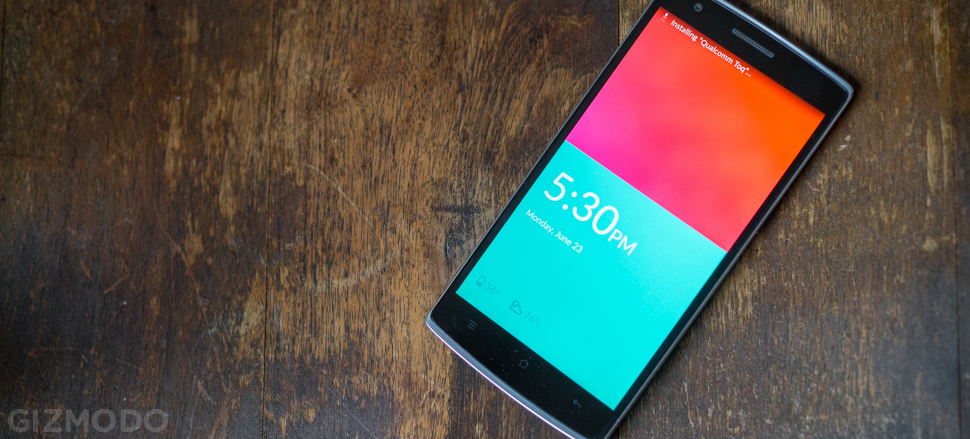
From the second you lay eyes/fingers on the OnePlus One, you can tell it’s a high-quality device, almost impossibly so for the low price tag. It’s got a solid sort of heft to it, and the screen is raised just slightly over the silver edges, which gives you a fun surface to run your fingers around when you’re nervous. It also looks great.
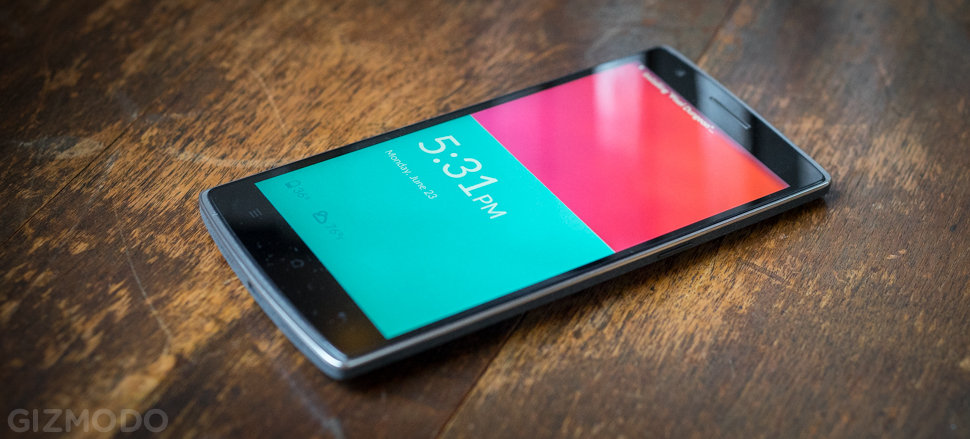
On the back, instead of opting for metal, your standard soft-touch plastic, or something glossy and cheap feeling, the OnePlus One we tested (“Sandstone Black”) has a fabric-y sort of texture. It doesn’t have any pull to it, and I’m inclined to think it’s just a strangely rough sort of plastic, but it feels like the inside of a tablet cover, the part that sits against the screen when it’s closed up. It’s a unique and strange but not entirely unwelcome material. It feels like it will get dirty quick — like you can’t set it down for fear that it will get greasy and stained — but after over a week of use it still looks great. It held up damn admirably to some time on my heinously unclean kitchen counter.
The style of the OnePlus One extends beyond just the phone though. This is the first gadget I’ve had in a long time where I’ve actually been impressed by the charging apparatus. That’s right; its micro USB cable is badass. It honestly gives cloth-coated cables a run for their money, and it’s completely untangleable.
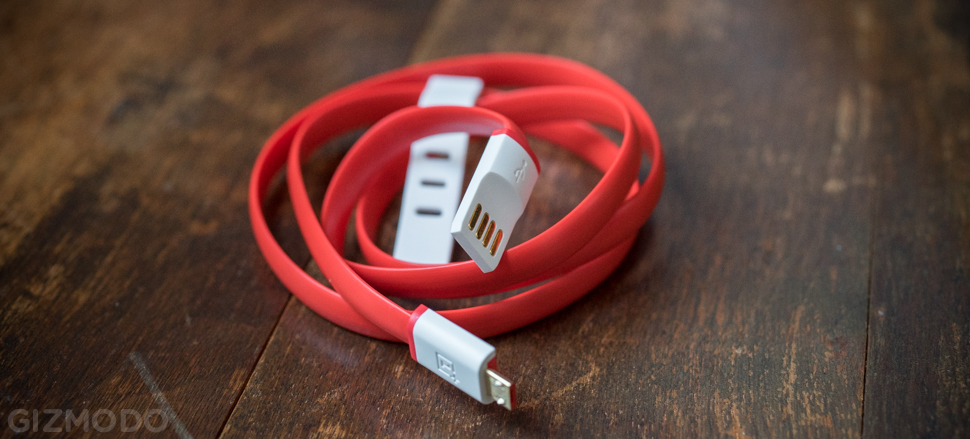
The screen, a 1080 x 1920 pixel IPS LCD display, looks great in pretty much all scenarios. It doesn’t have quite the contrast, deep blacks, or looks-good-outdoor-ness of an AMOLED display, but it is pretty. Definitely up to par with just about everything else out there.
And then at the bottom of the screen you’ve got your hardware buttons, long passé on flagship Android phones but a feature the OnePlus One seems content to keep. Oneeach for “Settings,” “Home,” and “Back,” in order from left to right. In other words, reversed from the order of software buttons that you’re used to on Android, which takes some adjustment. Also the “Settings” button will default to bringing up an app’s settings menu (questionably useful), though you can dig into Cyanogenmod’s settings to turn it into a traditional multitasking button.
Fortunately all these buttons sit pretty compact at the bottom, and Cyanogenmod lets you turn them off all together in favour of on-screen buttons. But I still found myself wishing they weren’t there.
Using It
Operating system
At the core of the OnePlus One-spericence is Cyanogenmod. For the uninitiated, this is essentially a forked, modified version of Android, kind of like Amazon’s Fire OS except not nearly as drastic a departure. It’s developed by the Cyanogenmod company rather than Google itself, and as such it lags behind Android updates just a little bit since Cyanogenmod’s engineers have to do their own mods before it gets to your phone.
Don’t let the name or the fact that it’s not straight out of Mountain View fool you, though; Cyanogenmod is pretty damn faithful to the spirit of stock Android. The UI design is basically identical, but for a few immediately visible changes which a little added flair that basically amounts to “hexagons everywhere.”
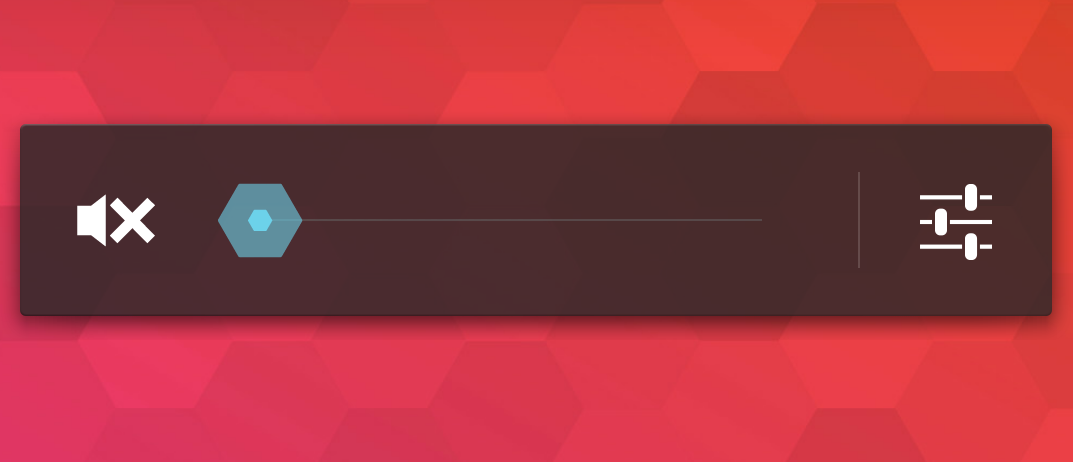
Cyanogenmod loves its hexagons.
Also unlike Fire OS, Cyanogenmod and the OnePlus One come with all the your favourite Google Apps installed by default. Future versions of the phone might not if Cyanogenmod ever loses Google’s blessing, but the current version is close enough to stock Android that Google has agreed to let its essential default apps be included.
So what are the differences, then? It becomes clear once you dig into the settings, where you can start turning on some of Cyanogenmod’s more useful features, most of which are just features that would be at home in Android but just aren’t there yet.
Perhaps the most helpful is something called “Profiles.” All profiles are option pre-sets you can create and save and trigger manually or set to trigger when you touch an NFC tag or connect to a given Wi-Fi network. So when I connect to my home Wi-Fi, for example, my “Home” profile can turn off my lock screen, jack up my notification sound, and disable GPS all automatically. It’s nothing you can’t hack together on your own in vanilla Android, but having it built in is great.
That’s just a taste of the “Oh huh neat. Why isn’t this in stock Android to begin with?” fun that Cyanogenmod has in store. There’s an endless buffet of options, like app shortcuts on the lock screen, and customisation that does everything from let you pick what tiles show up in the pull-down menu pan to changing the boot animation if you feel like it.

Performance
Of course it helps that the hardware underneath that custom OS just screams. The OnePlus One rocks a 2.5GHz Snapdragon 801 — the fastest lil phone chip out there right now — and backs it up with 3GB of RAM. The result is a phone that almost never stutters, whether you’re just zooming around the homescreen or playing some Hitman Go. I never ran into any performance issues except for a little freakout where Snapchat was freezing up, but I’m pretty sure that was Snapchat’s fault.
With a serious engine under the hood, and that big beautiful display to run, battery life is a concern. Luckily the One’s beefy 3100 mAh battery packs enough juice to get you through the day. I spent a big chunk of my time with the OnePlus One at my parent’s place, and though I was getting up at 11 am every day (awwww yeaaaaah) I was putting the One through seriously heavy use. We’re talking hours of reading Twitter on the couch, podcast listening, and general messing around while waiting for something to happen in a one-horse town. Multiple sustained sessions of 45 minutes-plus. And every day, the One still had a good 25 per cent battery life when 2 or 3 AM rolled around. I never would have gotten away with that on my Nexus 5.

The only catch is that the One will really sip juice if you try to charge it with an underpowered charger. When I attached it to the same (random) charger that I use to charge my Nexus 5, I woke up to find that it had only gone from 10 per cent to 75 per cent in the 6 hours I had been sleeping. Though when you use the presumably more capable (and damn stylish) charger the One actually comes with, charge times are much more reasonable.
Camera
OK, the OnePlus One’s camera is not great, but it’s not a total slouch either. The 13MP shooter performs pretty well in daylight, but less so in the dark of the night. I used it to capture unflattering pictures at my sister’s high school graduation and the results hold up pretty well, but a lot of my shots came out blurry because the image stabilisation is pretty meh, and the autofocus speed is relatively slow. It will get the job done if you’ve got good lighting and you’re not in a rush, but it’s nothing to write home about.
I also gave the OnePlus One to my colleague Mario, who’s a bit more qualified to suss out the finer points of smartphone camera-ry, and his takeaways were that the image stabilisation was definitely pretty bad — even controlling for his own extra-shaky hands — and that the low-light performance was “a catastrophe” which I think this sample shot bears out pretty well.

All that said, this was using the stock Camera app. The results once you boot up the Cyanogenmod camera app (which honestly I managed to forget about almost entirely) get a fair bit better. The stabilisation improves, and the low light performance is way less of a joke. It also helps that the Cyanogenmod camera has a fully customisable interface, so you can move the buttons around to the best on-screen position that will keep your fingers out of the way of the camera on the back. And you’ve got options like burst fire, and HDR in there as well.
Using the right app brings the One’s camera a lot closer to par, but it’s not a feature you’d want to lead with. For a $US300 phone, though, it’s hard to complain. And it’s still better than the Nexus 5 if not by a whole lot.
Like
Cyanogenmod out of the box is great. Its changes are non-intrusive enough that the OnePlus One can and does feel like a stock Android device. If you have any familiarity with Android, you won’t get lost in Cyanogenmod the same way that you might in proprietary skins. And because Cyanogenmod isn’t just a skin but instead an operating system, it offers superpowers that go pretty deep.
Being able to pick and choose between using hardware navigation buttons or software navigation buttons is nice, and touch gestures that work even when the screen is off are pretty neat when they aren’t misfiring. These are the kinds of Android tweaks that you would normally have to fall down a hole of rooting and flashing for, but with the OnePlus One, there’s no barrier to entry.
The One is beautiful. Its subtle curves and textured back really make it a pleasure to hold. It’s the kind of hardware that makes people say “oooOOOooo what is this?” in a good way. It’s hard to make a rectangular slab feel unique, but the way the screen is set above the metal rim is both cool and subtle. It’s an all-around good looking piece of tech.
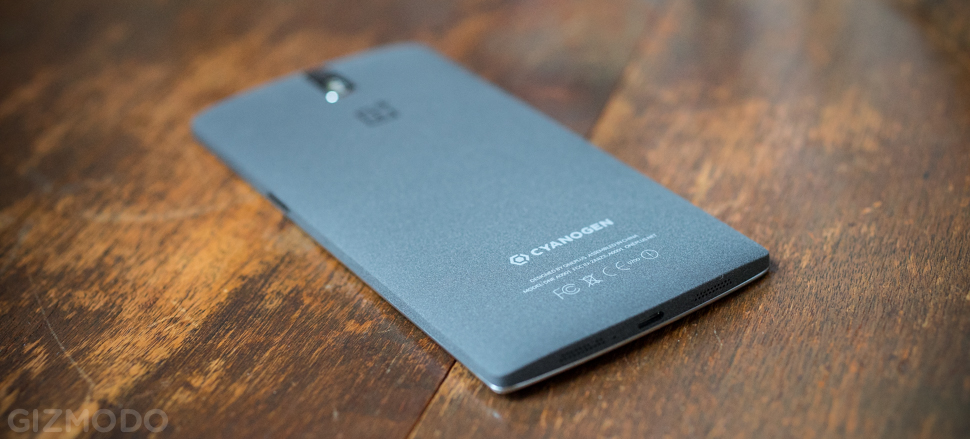
It starts at $529 from MobiCity or $US300 if you order it States-side and have it shipped here, and in the US it’s just $US350 for a 64GB model. I mean, what? That is nuts, and it makes up for pretty much any minor quibble you could possibly have with this thing.
No Like
Speaking of minor quibbles, there are a few to have. While Cyanogenmod is relatively unintrusive, some of its extra features that are on by default do not work well and are a drag. I can’t even count the number of times my One’s flash turned on in my pocket because it thought my leg was drawing a “V” on the screen, the gesture that enables torch mode. But you can just turn that off.
Built-in physical navigation buttons feel and look silly. Fortunately they’re small and well-placed in the bezel, so if you decide to turn them off through Cyanogenmod and opt for the (far superior) on-screen solution, they don’t feel like they’re eating up too much space.

The camera is not great. It is not totally unusable or anything, but if “a good camera” is anywhere on the top half of things you are looking for in a phone, you are probably going to be disappointed. Ditto the speakers.
The OnePlus One a little big. There’s nothing wrong with a big phone if you are into that, but the it fails my one test of ergonomics: I can’t easily swipe down the notification bar with my thumb while supporting the phone’s weight with my pinky, and I have biggish hands and longish fingers (according to every music teach I’ve ever had, anyway). It’d be nice if there was a smaller option. Something closer to 5 inches.
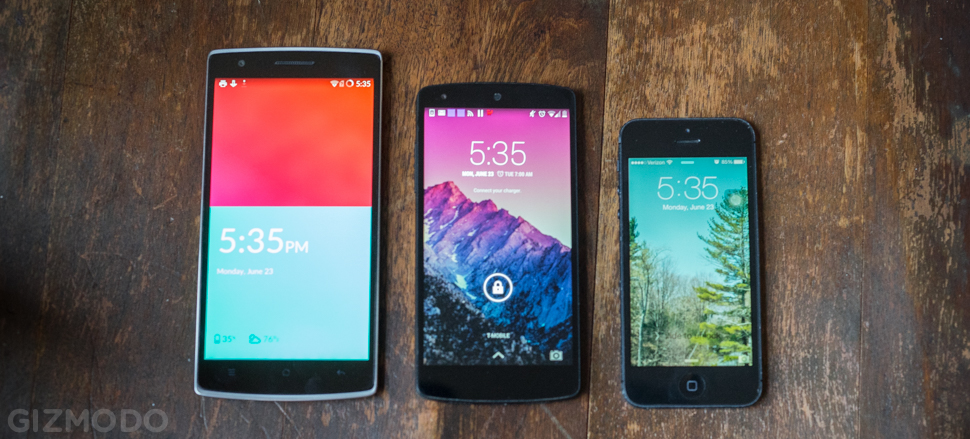
All the extra features of Cyanogenmod — like customisable profiles and theming options that let you do everything up to changing the boot animation — are great, but running an alternate OS is a speed bump to getting new features from Google. When the new L release comes out, you’ll have to wait for it to make its way into Cyanogenmod, which will probably take a few months. While the OnePlus One feels like a Nexus in price and usability, it won’t get quick OS updates like one.
Should You Buy It?
Yes! In a heartbeat! If you can. The big catch with the OnePlus One is that you need an invite before you can shell out for one, and demand is far outstripping supply. So if you want to buy one of these you’ll need to know somebody, or luck into an invite by chance.
And before you ask: No, I do not have any invites.
It’s $529 for a 16GB version. It’s a steal. I think I’ll be happy to move back to my slightly smaller Nexus 5, but if you can get your hands on an invite, the OnePlus One is a completely viable alternative to a Nexus, both in experience and in price. That’s a pretty huge accomplishment.
Is the OnePlus One the flagship killer it claims to be? It certainly could be, but only if it finds a way to show up in force. For now it’s an awesome oddity that will take some connections and/or dumb luck to get your hands on. But if you get the chance, take it.
